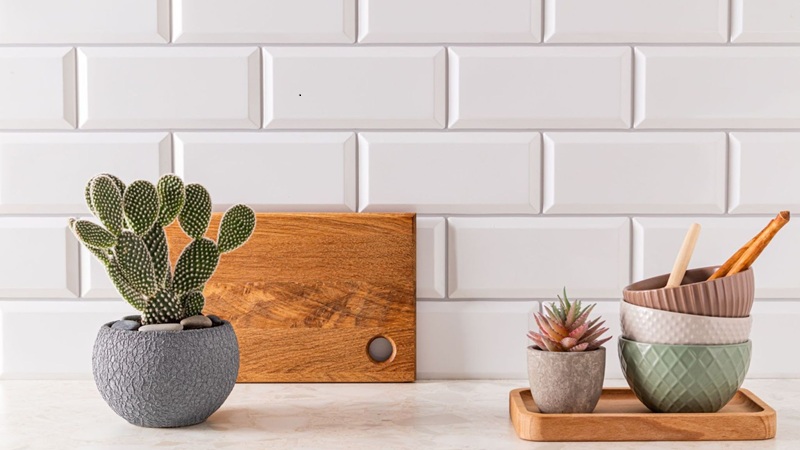Ready to transform your space with a simple design trick that never goes out of style? Subway tiles are the secret weapon behind countless stunning kitchens and bathrooms, offering a timeless yet surprisingly fresh look.
More than just classic white rectangles, these tiles have evolved into bold statements that bring personality and charm to any room.
Revolutionary Subway Tile Patterns That Redefine Spaces
Moving beyond traditional horizontal layouts opens up a world of visual possibilities that can make even small spaces feel dramatically different.
Vertical Stacking: Creating Height and Drama
Vertical installations trick the eye into seeing taller ceilings and more spacious rooms. This technique works especially well in bathrooms with standard 8-foot ceilings. The unbroken vertical lines draw your gaze upward, creating an illusion of height that’s particularly effective in narrow spaces.
The tile installation tips for vertical layouts require extra attention to your starting point. Begin with a level reference line and work from the center outward to ensure symmetrical gaps at each end.
Herringbone and Chevron Arrangements
These sophisticated patterns transform humble subway tiles into striking focal points. Herringbone creates a classic, timeless feel while chevron delivers more contemporary energy. Both patterns require precise cutting at edges and corners, so factor in about 15% extra material for waste.
Planning is crucial here – sketch your pattern on graph paper before starting, and consider hiring professionals for complex layouts.
Mixed-Size Geometric Combinations
Combining different subway tile sizes creates custom patterns that look unique. Try pairing standard 3×6 tiles with 2×8 or 4×12 formats for a dynamic visual rhythm. This approach works particularly well for a subway tile backsplash kitchen where you want something special but not overwhelming. Digital planning tools can help visualize these combinations before you commit to purchasing materials.
Color Psychology and Subway Tile: Beyond Basic White
Color choices in subway tile design go way beyond aesthetics – they influence how people feel in your space.
Trending Color Palettes for 2024-2025
This year’s home decor trends favor earthy, calming tones over stark whites. Sage green subway tiles create a spa-like atmosphere that’s perfect for bathrooms, while warm terracotta adds Mediterranean charm to kitchens. Navy blue makes a bold statement without being too dramatic for most homeowners.
These colors work because they feel both current and timeless. You won’t look at sage green tiles in five years and think they’re dated.
Bold Contrast and Subtle Harmony
The grout color you choose can completely change your tile’s personality. Dark grout with light tiles creates definition and visual interest, while matching grout colors gives a seamless, modern appearance.
Consider the room’s natural light when making color decisions – north-facing rooms benefit from warmer tile colors, while south-facing spaces can handle cooler tones.
Textural Innovation in Modern Subway Tile Design
Texture adds the physical dimension that makes spaces memorable and engaging to multiple senses.
3D and Dimensional Subway Tiles
Raised surface patterns create shadow play that changes throughout the day as light shifts. These dimensional tiles work beautifully as accent walls in living rooms or behind vanities in powder rooms. The shadows add depth without requiring any additional decorative elements.
Keep in mind that textured surfaces require more maintenance than flat tiles, especially in high-splash areas.
Handcrafted and Artisanal Finishes
Imperfect edges and handmade qualities bring warmth to spaces that might otherwise feel too sterile. These tiles often cost more than machine-made versions, but the character they add is worth the investment for many homeowners.
Local artisans sometimes offer custom glazes or textures that you won’t find in big box stores, creating truly one-of-a-kind installations.
Room-Specific Subway Tile Applications Beyond Kitchens
Smart designers use subway tiles throughout the home, not just in traditional backsplash applications.
Transforming Living Spaces with Accent Walls
Floor-to-ceiling subway tile installations create stunning focal points in family rooms and dining areas. This technique works especially well around fireplaces, where the tile’s clean lines complement both traditional and modern mantels.
The key is choosing colors and patterns that enhance rather than compete with your existing furnishings.
Bathroom Innovation Beyond Shower Walls
Subway tiles make excellent flooring when you choose appropriate sizes and finishes. Smaller formats provide better traction, while larger tiles create a more spacious feeling. Consider heated tile systems for luxury comfort in master bathrooms.
Vanity backsplashes using subway tiles tie the whole room design together while protecting walls from water damage.
Outdoor and Transitional Space Applications
Weather-resistant subway tiles work beautifully in covered patios and mudrooms. These spaces benefit from tiles that can handle temperature changes and occasional moisture while maintaining their appearance over time.
Pool areas require specialized materials, but subway-style tiles designed for wet environments create a cohesive design flow from indoor to outdoor spaces.
Professional Installation Mastery and DIY Success
Proper installation makes the difference between amateur-looking results and professional-grade transformations.
Essential Preparation and Planning
Substrate preparation determines your project’s long-term success. Walls must be clean, level, and properly primed before tile installation begins. Waterproofing is crucial in wet areas – don’t skip this step to save money.
Invest in quality tile spacers and leveling systems for consistent results that look professionally installed.
Advanced Finishing Techniques
Grout selection affects both appearance and maintenance requirements. Epoxy grouts resist staining better than traditional options, making them ideal for kitchen backsplash ideas where cooking splatters are common.
Proper sealing protects your investment and keeps tiles looking new for years. Different materials require different sealing products, so research your specific tile type.
FAQs
How can I make my subway tile more interesting?
Try choosing tiles with more character and texture, then pair them with similarly colored grout for less contrast. Square shapes instead of rectangles also add visual interest.
Why are tiles important in interior design?
Tiles offer both practicality and aesthetics in various materials. Ceramic tiles are particularly celebrated for their durability and adaptability across different applications.
What patterns can you do with subway tile?
Popular patterns include classic running bond, vertical layouts, 45-degree herringbone, basket weave, stacked bond arrangements, and creative combinations of these traditional approaches.
Your Next Design Adventure Awaits
Subway tile design continues evolving because these simple shapes adapt to changing interior design ideas while maintaining their fundamental appeal. Whether you’re drawn to classic white rectangles or bold colored patterns, the key is choosing applications that reflect your style.
The best subway tile projects don’t just follow trends – they create spaces that feel authentically yours while standing the test of time. Sometimes the most transformative design choices are the ones that seem surprisingly simple.
Image Source: Envato









Leave a Reply